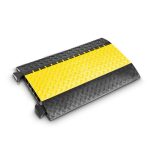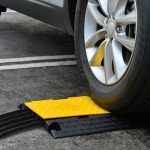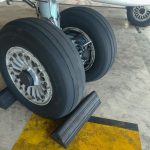Introduction
Why make your own speed bumps?
There are several reasons why you might want to make your own speed bumps for private property. Firstly, it can be a cost-effective solution compared to purchasing pre-made speed bumps. Secondly, making your own speed bumps allows you to customize the size and shape to fit your specific needs. Additionally, DIY speed bumps can be made from materials that are readily available, making it a convenient option for those who want to take matters into their own hands. Finally, by making your own speed bumps, you have greater control over the installation process, ensuring that they are installed correctly and in the most effective locations.
Benefits of DIY speed bumps
There are several benefits to creating your own DIY speed bumps for private property. Firstly, it can help to reduce the speed of vehicles on your property, making it safer for pedestrians and other drivers. Secondly, it can help to prevent accidents and damage to property by slowing down vehicles. Additionally, DIY speed bumps are a cost-effective solution compared to purchasing pre-made speed bumps. Finally, creating your own speed bumps allows you to customize the size and shape to fit your specific needs and preferences.
Materials Needed
Concrete mix
Once you have marked the area where you want to install the speed bumps, it’s time to mix the concrete. You can use a ready-to-mix concrete bag or make your own mix by combining cement, sand, and gravel in the right proportions. Follow the instructions on the bag or use a concrete calculator to determine the amount of materials you need. Mix the ingredients in a wheelbarrow or a mixing tray until you get a smooth and consistent mixture. Make sure to wear protective gear such as gloves and a mask while mixing the concrete. Once the mix is ready, you can start pouring it into the molds you have prepared for the speed bumps.
Bucket
The bucket method is another popular DIY speed bump option. To create a bucket speed bump, you will need to gather a few supplies, including a 5-gallon bucket, sand or gravel, and a shovel. Begin by digging a hole in the ground where you want the speed bump to be placed. Then, fill the bucket with sand or gravel and place it upside down in the hole. Finally, cover the bucket with dirt and pack it down firmly. The weight of the bucket and the contents inside will create a sturdy and effective speed bump for your private property.
Shovel
Once you have marked the area where you want to install the speed bump, it’s time to start digging. Use a shovel to excavate the ground to the desired depth and width of the speed bump. Make sure to remove any rocks, debris, or roots that may interfere with the installation process. It’s important to create a level surface for the speed bump to ensure that it functions properly. Take your time and be patient while digging to avoid any accidents or injuries.
Measuring tape
Once you have your measuring tape in hand, it’s time to determine the length and width of your speed bump. The standard size for a speed bump is 12 feet in length and 3-4 inches in height. However, you can adjust the dimensions to fit your specific needs. Keep in mind that the width of the speed bump should be slightly wider than the width of your vehicle’s tires to ensure maximum effectiveness. Once you have your measurements, mark the area where the speed bump will be placed using spray paint or chalk.
Marker
Marker: Once you have determined the location and size of your DIY speed bumps, it is important to mark them clearly to ensure that drivers are aware of their presence. You can use spray paint or reflective tape to mark the edges of the speed bumps. Make sure the markings are visible during the day and at night. Additionally, you may want to consider placing signs near the speed bumps to warn drivers to slow down. By clearly marking your DIY speed bumps, you can help prevent accidents and keep your property safe.
Water
Water can be a useful tool when creating DIY speed bumps for private property. By using a hose or sprinkler system, you can wet the area where you plan to install the speed bump. This will help to compact the soil and make it easier to shape the bump. Additionally, wetting the area can help to prevent dust from kicking up during the construction process. However, be sure to let the area dry completely before installing the speed bump to ensure that it sets properly.
Optional: Rebar or wire mesh
If you want to make your DIY speed bumps even more durable, you can add rebar or wire mesh to the concrete mix. Rebar is a steel bar that is commonly used to reinforce concrete structures, while wire mesh is a sheet of interconnected wires that can also provide additional strength. To use either of these materials, simply place them in the middle of the concrete mix before pouring it into the mold. This will help to prevent cracking and ensure that your speed bumps last for years to come. However, keep in mind that adding rebar or wire mesh will also increase the cost and complexity of the project, so it may not be necessary for all situations.
Steps to Make DIY Speed Bumps
Step 1: Choose the location
Once you have decided to install speed bumps on your private property, the first step is to choose the location where you want to place them. It is important to identify areas where speeding is a problem, such as near playgrounds, schools, or residential areas. You should also consider the traffic flow and the speed limit in the area. Once you have identified the location, measure the width of the road and determine the length of the speed bump you need. Keep in mind that the speed bump should be long enough to slow down the vehicles but not too long that it causes discomfort to the drivers.
Step 2: Measure and mark the area
After you have determined the location of your speed bumps, it’s time to measure and mark the area. Use a measuring tape to determine the length and width of the area where you want to install the speed bumps. Once you have the measurements, mark the area using spray paint or chalk. Make sure to mark the area clearly so that you can easily see where the speed bumps will be placed. It’s important to measure and mark the area accurately to ensure that the speed bumps are installed in the right location and are effective in slowing down vehicles.
Step 3: Prepare the concrete mix
Once you have your molds ready, it’s time to prepare the concrete mix. You can purchase pre-mixed concrete from your local hardware store or mix your own using cement, sand, and gravel. The ratio of these ingredients will depend on the size of your speed bumps and the desired strength of the concrete. Generally, a ratio of 1:2:3 (cement:sand:gravel) is recommended for a strong and durable mix. Mix the ingredients thoroughly in a wheelbarrow or mixing tray, adding water gradually until you achieve a thick, workable consistency. Avoid adding too much water, as this can weaken the concrete and cause cracking.
Step 4: Pour the concrete mix
Once you have prepared the area and set up the forms, it’s time to pour the concrete mix. Follow the instructions on the bag of concrete mix and mix it thoroughly with water in a wheelbarrow or mixing tray. Pour the mix into the forms, making sure it is evenly distributed and fills the entire area. Use a trowel to smooth out the surface and remove any air pockets. Allow the concrete to dry and cure for at least 24 hours before removing the forms. Once the forms are removed, you can add any finishing touches such as painting or adding reflective tape to increase visibility. Your DIY speed bumps are now ready to use!
Step 5: Smooth the surface
After allowing the concrete to dry for at least 24 hours, it’s time to smooth the surface of your DIY speed bumps. Use a concrete float to smooth out any rough spots or bumps on the surface. Make sure to work in small sections and use a circular motion to ensure an even finish. Once you’ve smoothed out the entire surface, let the concrete cure for another 24 hours before driving over it. This will ensure that the surface is completely dry and hardened, and your DIY speed bumps will be ready to use.
Step 6: Add rebar or wire mesh (optional)
Adding rebar or wire mesh to your DIY speed bumps is an optional step, but it can provide additional strength and durability. If you live in an area with heavy traffic or large vehicles, adding rebar or wire mesh can help prevent the speed bumps from cracking or breaking under the weight of vehicles. To add rebar or wire mesh, simply place it on top of the first layer of concrete before adding the second layer. Make sure it is evenly distributed and fully covered by the concrete to ensure maximum strength. Allow the speed bumps to dry completely before using them.
Step 7: Allow the concrete to dry
Once the concrete has been poured, it’s important to allow it to dry completely before removing the forms or driving over the speed bump. The drying time can vary depending on the weather conditions and the thickness of the concrete, but it typically takes at least 24 hours. It’s best to wait a few days before using the speed bump to ensure that it has fully cured and is strong enough to withstand the weight of vehicles. During the drying process, it’s important to keep the area around the speed bump clear and free from any debris or foot traffic that could damage the concrete.
Step 8: Test the speed bump
After installing the speed bump, it’s important to test it out to ensure that it’s working effectively. You can do this by driving over the speed bump at different speeds and observing how your vehicle reacts. If you feel a jolt or bump, then the speed bump is doing its job. However, if you don’t feel any resistance, then you may need to adjust the height or angle of the speed bump. It’s also a good idea to have others test the speed bump to get their feedback and make any necessary adjustments. Remember, the goal is to slow down traffic and improve safety on your private property.
Maintenance and Safety
Regular inspection
Regular inspection is crucial to ensure that your DIY speed bumps are in good condition and functioning properly. It is recommended to inspect them at least once a month to check for any signs of wear and tear, cracks, or damage. If you notice any issues, it is important to address them immediately to prevent any accidents or injuries. Additionally, regular inspection can help you identify any areas that may require additional speed bumps or modifications to improve the safety of your private property. By taking the time to inspect your DIY speed bumps regularly, you can ensure that they are effective and provide the necessary traffic calming measures for your property.
Repairs
If your DIY speed bumps have been in place for a while, it’s important to periodically check them for any damage or wear and tear. Repairs may be necessary to ensure they continue to function properly and provide the necessary safety measures. If you notice any cracks or holes, fill them in with additional concrete or asphalt. You may also need to repaint the speed bumps to ensure they remain visible to drivers. Regular maintenance and repairs will help extend the lifespan of your DIY speed bumps and keep your private property safe for all who use it.
Safety precautions
Before you start making your own DIY speed bumps, it’s important to take some safety precautions. First, make sure you have the necessary tools and materials to complete the project safely. Wear protective gear such as gloves and safety glasses to avoid any injuries. Additionally, ensure that the area where you will be installing the speed bumps is clear of any debris or obstacles that could cause accidents. Finally, be mindful of any potential hazards such as traffic or pedestrians while working on the project. By taking these safety precautions, you can ensure a safe and successful DIY speed bump installation.
Conclusion
Summary
In summary, making your own DIY speed bumps for private property is a cost-effective and easy solution to control the speed of vehicles on your property. By using materials such as rubber, asphalt, or concrete, you can create speed bumps that are durable and long-lasting. It is important to ensure that the speed bumps are installed properly and meet any local regulations or guidelines. With these simple steps, you can improve the safety of your property and prevent accidents caused by speeding vehicles.









5